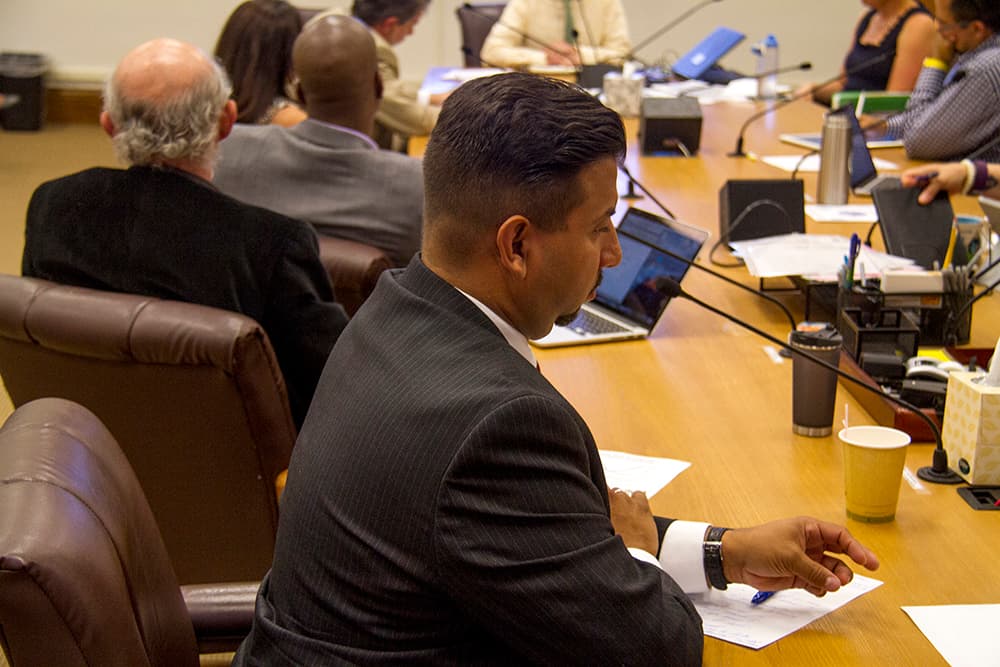
Denver City Councilman Paul Lopez has a white whale, and it's the lack of a proper sidewalk on the north side of Florida Avenue between Irving Street and Knox Court.
Charles M. Schenck Community School is to the west; there's a daycare to the east. Kids walk to school along this route, and parents push babies in strollers. Especially when it snows, people end up walking in the street.
Every year for nine years, he has asked for funding to put in a real sidewalk. Every year, it doesn't happen. The constituent who lobbied the most persistently for this sidewalk passed away a few years ago without ever seeing a change.
"It keeps getting lost," he said. "There are people who are no longer alive to see it."
Sidewalks and the lack thereof have more visibility now in the public discussion.
Denver has a Vision Zero campaign to improve pedestrian safety, and the 2017 budget includes $2.5 million to put in sidewalks that are missing from city-owned property. Mayor Michael Hancock has agreed to work with city council members to come up with money to help homeowners pay for sidewalk maintenance. It might take a new fee or tax to do that.
And the Denveright planning process has identified sidewalks and crossings as "the most basic and critical need for pedestrians." Some 520 miles of city streets have no sidewalk on either side. That's 23 percent of all city streets and includes 26 percent of arterial streets -- those with a lot of fast-moving traffic.
During the Denver City Council retreat earlier this month, council members put big numbers for sidewalks on their budget wishlists, with many saying this year's planned general obligation bond represents an opportunity to right a longstanding wrong.
Councilman Paul Kashmann asked for $80 million to create a "complete, safe and accessible sidewalk system." Councilman Jolon Clark asked for $30 million to repair existing sidewalks, upgrade old sidewalks that are now considered "substandard" -- too skinny and right up against the road, in the post-war style -- and build out missing stretches of sidewalk. Others wanted millions for sidewalks on certain stretches of road or to help people get to bus stops and light rail stations.
Lopez doesn't think Florida Avenue should have to wait for a bond issue. He estimates the cost at $125,000, including utility relocation and landscaping, and he wants to see it in the 2018 budget. Just like he wanted to see it in the 2017 and 2016 and 2015 and so on budgets.
The argument he always hears is that there are lots of places that need sidewalks. Florida Avenue isn't particularly special.
Last year, public works took some extra asphalt and put in a small strip of pavement right next to the road. This is a half-measure the city uses for streets that need sidewalks when a full fix is a long time away.
This should "provide some measure of assistance," public works spokeswoman Nancy Kuhn said via email. "However, we have not historically had a dedicated funding source for new sidewalk construction, and there are needs citywide."
This is Lopez' response: "Well, let's start somewhere. Let's fill in the gaps."

How does the city decide which sidewalks to pave?
City ordinance puts the responsibility for sidewalk maintenance on private property owners. According to Kuhn, the city builds sidewalks:
- when it's building something new like a rec center or library,
- when it's reconstructing a street, like it's doing now on Brighton Boulevard, South Broadway and Federal,
- when it's constructing improvements related to bus stops and light rail stations, like the new sidewalks on Blake Street near the 38th and Blake station.
Denver Public Works has also spent about $20 million over the last two years to put in missing ramps to comply with the Americans with Disabilities Act and has another $10 million budgeted this year.
The $2.5 million for missing sidewalks on city property should cover about eight miles of new sidewalk.
Kuhn said it's possible bond money could be used for sidewalks. It just depends on how the prioritization process goes between some 3,000 project requests from the public and city officials. Those will be narrowed down over the course of the next six months. Voters would need to approve whatever the city comes up with in November.
Bond money can be used for capital projects -- new construction -- but not for ongoing sidewalk maintenance. That's its own issue and would need a different funding source.
"There is also more to sidewalk construction than you might think, including ensuring proper drainage with curb and gutter work and having enough public right of way to build the sidewalk," Kuhn said. "Generally speaking, there can be additional complexities, including utility conflicts (such as power poles), private landscaping improvements, retaining walls, planting beds, etc. occupying spaces where new sidewalks would go that have to be addressed."
Will this stretch of Florida get a real sidewalk anytime in the foreseeable future?
"We do not have funding to address this stretch of Florida at this time," Kuhn said.












